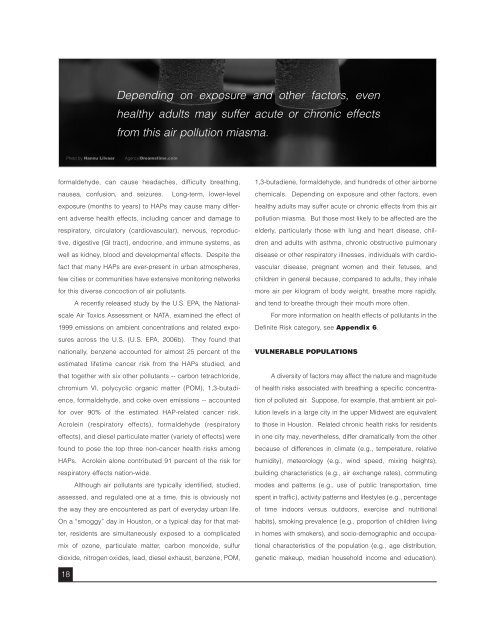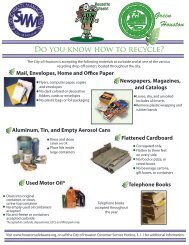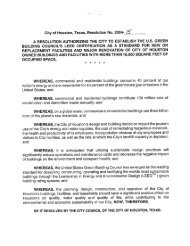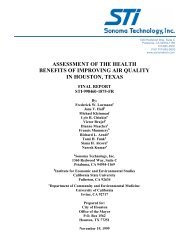Depend<strong>in</strong>g on exposure and other factors, evenhealthy adults may suffer acute or chronic effectsfrom this air pollution miasma.Photo by Hannu LiivaarAgency/Dreamstime.comformaldehyde, can cause headaches, difficulty bre<strong>at</strong>h<strong>in</strong>g,nausea, confusion, and seizures. Long-term, lower-levelexposure (months to years) to HAPs may cause many differentadverse health effects, <strong>in</strong>clud<strong>in</strong>g cancer and damage torespir<strong>at</strong>ory, circul<strong>at</strong>ory (cardiovascular), nervous, reproductive,digestive (GI tract), endocr<strong>in</strong>e, and immune systems, aswell as kidney, blood and developmental effects. Despite thefact th<strong>at</strong> many HAPs are ever-present <strong>in</strong> urban <strong>at</strong>mospheres,few cities or communities have extensive monitor<strong>in</strong>g networksfor this diverse concoction of air pollutants.A recently released study by the U.S. EPA, the N<strong>at</strong>ionalscale<strong>Air</strong> Toxics Assessment or NATA, exam<strong>in</strong>ed the effect of1999 emissions on ambient concentr<strong>at</strong>ions and rel<strong>at</strong>ed exposuresacross the U.S. (U.S. EPA, 2006b). They found th<strong>at</strong>n<strong>at</strong>ionally, benzene accounted for almost 25 percent of theestim<strong>at</strong>ed lifetime cancer risk from the HAPs studied, andth<strong>at</strong> together with six other pollutants -- carbon tetrachloride,chromium VI, polycyclic organic m<strong>at</strong>ter (POM), 1,3-butadience,formaldehyde, and coke oven emissions -- accountedfor over 90% of the estim<strong>at</strong>ed HAP-rel<strong>at</strong>ed cancer risk.Acrole<strong>in</strong> (respir<strong>at</strong>ory effects), formaldehyde (respir<strong>at</strong>oryeffects), and diesel particul<strong>at</strong>e m<strong>at</strong>ter (variety of effects) werefound to pose the top three non-cancer health risks amongHAPs. Acrole<strong>in</strong> alone contributed 91 percent of the risk forrespir<strong>at</strong>ory effects n<strong>at</strong>ion-wide.Although air pollutants are typically identified, studied,assessed, and regul<strong>at</strong>ed one <strong>at</strong> a time, this is obviously notthe way they are encountered as part of everyday urban life.On a “smoggy” day <strong>in</strong> <strong>Houston</strong>, or a typical day for th<strong>at</strong> m<strong>at</strong>ter,residents are simultaneously exposed to a complic<strong>at</strong>edmix of ozone, particul<strong>at</strong>e m<strong>at</strong>ter, carbon monoxide, sulfurdioxide, nitrogen oxides, lead, diesel exhaust, benzene, POM,1,3-butadiene, formaldehyde, and hundreds of other airbornechemicals. Depend<strong>in</strong>g on exposure and other factors, evenhealthy adults may suffer acute or chronic effects from this airpollution miasma. But those most likely to be affected are theelderly, particularly those with lung and heart disease, childrenand adults with asthma, chronic obstructive pulmonarydisease or other respir<strong>at</strong>ory illnesses, <strong>in</strong>dividuals with cardiovasculardisease, pregnant women and their fetuses, andchildren <strong>in</strong> general because, compared to adults, they <strong>in</strong>halemore air per kilogram of body weight, bre<strong>at</strong>he more rapidly,and tend to bre<strong>at</strong>he through their mouth more often.For more <strong>in</strong>form<strong>at</strong>ion on health effects of pollutants <strong>in</strong> theDef<strong>in</strong>ite Risk c<strong>at</strong>egory, see Appendix 6.VULNERABLE POPULATIONSA diversity of factors may affect the n<strong>at</strong>ure and magnitudeof health risks associ<strong>at</strong>ed with bre<strong>at</strong>h<strong>in</strong>g a specific concentr<strong>at</strong>ionof polluted air. Suppose, for example, th<strong>at</strong> ambient air pollutionlevels <strong>in</strong> a large city <strong>in</strong> the upper Midwest are equivalentto those <strong>in</strong> <strong>Houston</strong>. Rel<strong>at</strong>ed chronic health risks for residents<strong>in</strong> one city may, nevertheless, differ dram<strong>at</strong>ically from the otherbecause of differences <strong>in</strong> clim<strong>at</strong>e (e.g., temper<strong>at</strong>ure, rel<strong>at</strong>ivehumidity), meteorology (e.g., w<strong>in</strong>d speed, mix<strong>in</strong>g heights),build<strong>in</strong>g characteristics (e.g., air exchange r<strong>at</strong>es), commut<strong>in</strong>gmodes and p<strong>at</strong>terns (e.g., use of public transport<strong>at</strong>ion, timespent <strong>in</strong> traffic), activity p<strong>at</strong>terns and lifestyles (e.g., percentageof time <strong>in</strong>doors versus outdoors, exercise and nutritionalhabits), smok<strong>in</strong>g prevalence (e.g., proportion of children liv<strong>in</strong>g<strong>in</strong> homes with smokers), and socio-demographic and occup<strong>at</strong>ionalcharacteristics of the popul<strong>at</strong>ion (e.g., age distribution,genetic makeup, median household <strong>in</strong>come and educ<strong>at</strong>ion).18
The reality is th<strong>at</strong>, even <strong>at</strong> similar ambient pollutant levels, airpollution-rel<strong>at</strong>ed health risks can diverge considerably not onlyfrom city to city, but also from community to community, neighborhoodto neighborhood, street to street, house to house, andperson to person.Just as different <strong>in</strong>dividuals may respond dissimilarly tothe same dose of a particular prescription medic<strong>in</strong>e, so too candifferent <strong>in</strong>dividuals be affected dissimilarly by equal concentr<strong>at</strong>ions(or doses) of air pollution. The n<strong>at</strong>ure, likelihood, andseverity of air pollution-rel<strong>at</strong>ed health effects are directly rel<strong>at</strong>edto the vulnerability of exposed <strong>in</strong>dividuals and popul<strong>at</strong>ions. Inthis context, vulnerability is used to mean the conditions determ<strong>in</strong>edby physical, social, economic, and environmental factorsor processes, which <strong>in</strong>crease the susceptibility of a communityor an <strong>in</strong>dividual to the impact of hazards. There are fourgeneral types of vulnerability th<strong>at</strong> <strong>in</strong>fluence air pollution-rel<strong>at</strong>edhealth effects: <strong>in</strong>ter-<strong>in</strong>dividual differences <strong>in</strong> biological susceptibility;differential exposure; disparities <strong>in</strong> preparedness tocope with air pollution exposure; and divergence <strong>in</strong> the abilityto recover from air pollution exposure. It is important to noteth<strong>at</strong> these c<strong>at</strong>egories are not mutually exclusive, and th<strong>at</strong> popul<strong>at</strong>ionswith disproportion<strong>at</strong>e numbers of vulnerable <strong>in</strong>dividualswill be more likely to suffer air pollution-rel<strong>at</strong>ed discomfort,dysfunction, disability, disease, and de<strong>at</strong>h (U.S. EPA, 2003).Biological Susceptibility - Some people are geneticallypredisposed to experience adverse effects from air pollutionbecause they have genetic polymorphisms th<strong>at</strong> change thelevel of expression of a gene or the activity of gene product,such as an enzyme. Life stage can also affect susceptibility,and it is well established th<strong>at</strong> pregnant women, fetuses, children,and the elderly tend to be more prone to air pollutionrel<strong>at</strong>edeffects. Furthermore, those with preexist<strong>in</strong>g medicalconditions, such as asthma or heart disease, are also more likelyto endure adverse effects from air pollution exposure.Differential Exposure - When two <strong>in</strong>dividuals or popul<strong>at</strong>ionshave different exposures to air pollution, they are <strong>at</strong> differentpo<strong>in</strong>ts on the dose-response curve, which means th<strong>at</strong>they may have dissimilar likelihoods of suffer<strong>in</strong>g adverseeffects. This can be true for contemporaneous exposure (e.g.,two <strong>in</strong>dividuals are exposed to different air pollution levels <strong>at</strong>the same time), historical exposure (e.g., two <strong>in</strong>dividuals areexposed to the same level now but had different exposures <strong>in</strong>the past), background exposure (e.g., two <strong>in</strong>dividuals have thesame exposure now to ambient (outdoor) air pollution but havedifferent current exposure to <strong>in</strong>door (or background) air pollution),and body burden (e.g., two <strong>in</strong>dividuals have the sameexposure now to air pollution but have different levels of environmentalchemicals, their metabolites, or reaction products <strong>in</strong>their bodies).Another important factor th<strong>at</strong> may affect disparities <strong>in</strong>exposure to ambient air pollution is the presence and use of aircondition<strong>in</strong>g (cool<strong>in</strong>g and he<strong>at</strong><strong>in</strong>g systems). The use of air condition<strong>in</strong>gisol<strong>at</strong>es <strong>in</strong>door from outdoor air, and decreases the<strong>in</strong>filtr<strong>at</strong>ion of ambient pollutants <strong>in</strong>to residences and other build<strong>in</strong>gs.Residents of economically disadvantaged neighborhoodsmay either not have air condition<strong>in</strong>g, or limit its use,result<strong>in</strong>g <strong>in</strong> dependence on n<strong>at</strong>ural ventil<strong>at</strong>ion, and thus gre<strong>at</strong>erexposure to outdoor pollutants.Disparities <strong>in</strong> Preparedness to Cope - Differences<strong>in</strong> the quality and quantity of cop<strong>in</strong>g systems and resourcesavailable to an <strong>in</strong>dividual or popul<strong>at</strong>ion can affect their ability towithstand the effects of air pollution exposure. For example,two children may be exposed to the same concentr<strong>at</strong>ion of airpollution, but one may suffer no ill effects because her parentscould afford disease immuniz<strong>at</strong>ions, rout<strong>in</strong>e medical and dentalcheckups, daycare, a healthy diet, and vitam<strong>in</strong> supplements,while the other may get sick because she did not have thesesame advantages - and thus was less able to withstand the airpollution <strong>in</strong>sult.Divergence <strong>in</strong> Ability to Recover - Differences <strong>in</strong>the quality and quantity of cop<strong>in</strong>g systems and resources availableto an <strong>in</strong>dividual or popul<strong>at</strong>ion can affect their ability torecover from the effects of air pollution. For example, two childrenwith air pollution-<strong>in</strong>duced respir<strong>at</strong>ory problems may beexposed to the same concentr<strong>at</strong>ion of air pollution, but one mayhave fewer symptoms, less severe symptoms, less frequentdisease episodes, slower progression of the disease, and abetter prognosis for full recovery because his parents are morehealth conscious, more knowledgeable about environmentally<strong>in</strong>duceddisease, more <strong>in</strong> control of their home environmentand, most importantly, more affluent, which means they canafford health <strong>in</strong>surance, better medical care, prescription medic<strong>in</strong>e,and more nutritious food (U.S. EPA, 2003).19
- Page 1 and 2: A Closer Look at Air Pollution in H
- Page 3 and 4: A Closer Look at Air Pollution in H
- Page 5 and 6: Task Force MembersResearch StaffKen
- Page 7 and 8: AcknowledgementsThe Task Force woul
- Page 10: Just because a task is difficult, h
- Page 13 and 14: ing, and route of exposure, and oth
- Page 15 and 16: and vulnerable subgroups. Substance
- Page 17 and 18: accurately from death certificates.
- Page 19: assessments, and monitoring data fr
- Page 23 and 24: ability, have inadequate means to c
- Page 25 and 26: Houston reaches $21,701. These are
- Page 27 and 28: In summary, we view the comparative
- Page 29 and 30: AppendicesPhoto by Heidi Bethel27
- Page 31 and 32: Photo by Heidi Bethelgrouping to a
- Page 33 and 34: Appendix 2the time period is repres
- Page 35 and 36: Appendix 3an appreciable risk of ad
- Page 37 and 38: Table A3.1. Health Values and Refer
- Page 39 and 40: Table A3.1. Health Values and Refer
- Page 41 and 42: Table A3.1. Health Values and Refer
- Page 43 and 44: Appendix 4Metals, Diesel PM Convers
- Page 45 and 46: Under advice from staff at the U.S.
- Page 47 and 48: Appendix 5Table A5.1. Uncertain Ris
- Page 49 and 50: Appendix 6Brief Descriptions of Hea
- Page 51 and 52: Appendix 7Summary Map and Table for
- Page 53 and 54: Appendix 8: Table 1Supplemental Tab
- Page 55 and 56: Appendix 8: Table 3Table A8.3. Poss
- Page 57 and 58: ReferencesHackett, P., Sikov, M., &







